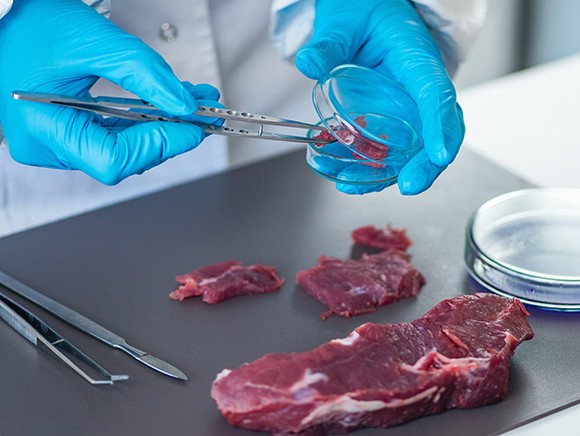
Consumers are demanding for healthier foods: food that is guaranteed to be food safe and have a clean label. Preventing food waste is high on the priority list as well, which is almost diametrically opposed to the clean label requirement: these products are typically more vulnerable in terms of colour, odour, flavour and microbiological shelf life. It is an enormous challenge for food producers to comply with those demands of the consumers.
Since the beginning of human history, methods have been developed to decrease the growth of micro-organisms in order to prevent food spoilage. We heat, dry, pickle, confit and smoke our foods. Some of these methods focus on decrease of the water content, which is necessary for micro-organisms to multiply. Another option to stop the reproduction of micro-organisms is to decrease the pH: e.g. by adding acids or ferment sugars. Currently, preservatives are added to foods during their shelf-life period to protect them against the undesired growth of pathogens or micro-organisms that cause spoilage.
For decades, there has been a great deal of controversy regarding the use of preservatives with E numbers: a reason for producers (of food, pharmaceuticals and cosmetics) to seek out alternatives for guaranteeing freshness. Various substances have since been determined to have a favourable effect on colour and scent, on slowing oxidation or improving microbiological shelf life. Unfortunately, the latter is often type-specific, which makes its application complex. At the International Congress of Meat Science and Technology (ICoMST) in Cork, different scientists presented the progress of their research into the effects of alternative preservatives in meat products.
The microbiological shelf life of food is determined by intrinsic and extrinsic factors in conjunction with the presence of microflora, which can reproduce under conditions that are favourable for them. Intrinsic factors are the presence of nutrients, the pH value, the Aw value, oxidation-reduction potential and the presence of antimicrobial substances. Extrinsic factors include the temperature of the environment (cooling), the storage time, the atmosphere in the environment (vacuum, MAP), the intensity of any added heat and the functionality of the packaging. The preservatives used (antimicrobial substances) have an E number between 200 and 253.
Benzoic acid is primarily effective against yeast and mould, but less so against bacteria. It occurs naturally in berries (cranberry) and to a lesser degree in cinnamon, mushrooms and clove. The preservative sorbic acid naturally occurs in rowan berries, but can also be mimicked chemically through various processes. It is primarily effective against mould and yeast in a slightly acidic environment. It has no effect on bacteria nor in non-acidic products (pH above 6.5) and can interact with other additives, specifically nitrates. Nitrite is a highly effective substance for eliminating Clostridium spores and works in neutral and slightly acidic environments. The preservative sulphite can only be used for potatoes, fruit, juice, syrup, beer and wine. One of the best-known antimicrobial substances is lactic acid, a substance that is produced by lactic acid bacteria. Lactic acid lowers the pH value. Examples of this are sauerkraut and fermented sausage, such as salami. There are lactic acid bacteria that form the antimicrobial substance nisin, which is effective against gram-positive micro-organisms.
The use of lactates in conjunction with acetate or diacetate is well known in the meat industry. What is less common is the use of vinegar (0.7%) in conjunction with tea extract. This has a substantial effect on Enterobacteriacea (no growth at 4°C) and results in a 50% extension of shelf life by delaying the growth of lactic acid bacteria and a doubling of the total number of microbes due to the delay in growth.
A combination of 0.25% added potassium acetate and potassium diacetate has proven to be effective against the reproduction of Listeria monocytogenes in cured (1.9% salt) turkey ham which was stored at 4°C for 12 weeks. Storing at 7°C was also feasible if the combination of potassium acetate and diacetate of 0.5% was added. In Mexico, research was begun into both antimicrobial and antioxidative substances that occur naturally in mushrooms. The extract of the mushroom species Pleurotus ostreatus did exhibit antimicrobial activity, yet the extract of Agaricus brasiliensis was clearly less effective. New results from this research is expected at the end of this year.
Another approach is the use of specific micro-organisms that are able to deactivate other bacteria. This is called bioprotection. It has been used for centuries in products such as fermented dry sausage. More active micro-organisms have been discovered over the past few decades. A Belgian study indicated that Carnobacterium maltaromaticum had an inhibitory effect on Listeria monocytogenes at -1°C and +4°C. However, Salmonella typhimurium and E. coli O157: H7 were not receptive to these strains, meaning these were also type-specific.
Therefore, the challenge is to link clean-label products with a good shelf-life strategy from all angles. In early 2019, Wageningen Food & Biobased Research will start the project “Synergy 4 Shelf life– clean label preservation strategies” and is inviting partners from the food industry to participate in a multidisciplinary consortium project. The goal is to develop new, clean-label shelf-life strategies in which mild preservation techniques (HPP, PEF, mild heat) are combined with agents that impact intrinsic factors (pH Aw, temperature).
Source: © MICROGEN/SHUTTERSTOCK.COM